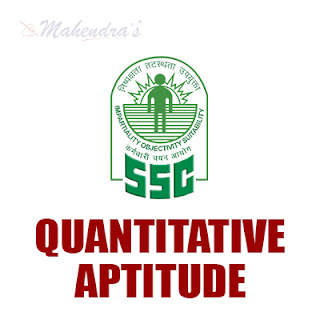In SSC exam, quantitative Aptitude section is more scoring and easy, if you know the shorts tricks and formulas of all the topics. So, it is important to know the basic concepts of all the topics so you can apply the short tricks and solve the question with the new concept sin lesser time while giving the quiz. It will help you to score more marks from this section in less time period. Quantitative Aptitude section basically measures your mathematical and calculation approach of solving the question. SSC Quiz of quantitative Aptitude section helps you to analyse your preparation level for upcoming SSC examination. Mahendra Guru provides you Quantitative Aptitude Quiz for SSC examination based on the latest pattern so that you can practice on regular basis. It will definitely help you to score good marks in the exam. It is the most important section for all the govt exams like Insurance, SSC-MTS, SSC CPO , CGL, CHSL, State Level, and other Competitive exams.
Mahendra Guru also provides you important notes and study material for all subject and test through its website, Mahendra Guru App and YouTube channel apart from it Speed Test Portal. Most of these preparation products are also available for purchase on my shop. You can also visit Mahendras.org to get more information about our endeavour for your success. You can also study in details through our E-Mahendras Facebook and Mahendra Guru YouTube channel of Quantitative Aptitude.
Q-1 The average of 8 persons is increased by 2 years ,when one of them whose age is 24 years is replaced by a new person. The age of the new person is -
8 लोगों की औसत आयु में 2 वर्ष की वृद्धि होती है। जब उनमें से एक 24 वर्ष की आयु वाले को एक नये आदमी से प्रतिस्थापित किया जाता है। तो नये आदमी की आयु क्या है?
(A) 32
(B) 36
(C) 40
(D) 42
Q-2 The age of Kiran and Arti is in the ratio 2 : 6. After 5 years, the ratio of their ages will becomes 6 : 8. Find the average of their ages after 10 years.
किरन और आरती की आयु का अनुपात 2 : 6 है। 5 वर्ष बाद उनकी आयु का अनुपात 6 : 8 होगा। तो 10 वर्ष बाद उनकी आयु का औसत क्या है?
(A) 18
(B) 15
(C) 16
(D) 12
Q-3 If x : y = 3 : 1, then x3 - y3 : x3 + y3 = ?
यदि x : y = 3 : 1, तो x3 - y3 : x3 + y3 = ?
(A) 14:13
(B) 17:15
(C) 13:14
(D) 15:17
Q-4 A mixture of a certain quantity of milk with 32 litres of water is worth Rs. 1.50 per litre. If pure milk be worth Rs. 4.50 per litre, how much milk is there in the mixture?
एक मिश्रण की कुछ दूध की मात्रा 32 ली. पानी के साथ 1.50 रू. प्रति ली. है। यदि शुद्ध दूध 4.50 रू. प्रति ली. है, तो मिश्रण में कितना दूध है?
(A) 12
(B) 24
(C) 16
(D) 20
Q-5 60% of the students in a school are boys and the number of girls is 972, how many boys are there in the school?
एक स्कूल में 60% लड़के और 972 लड़कियाँ हैं तो स्कूल में लड़कों की संख्या कितनी है?
(A) 1458
(B) 1532
(C) 1478
(D) 1518
Q-6 The cost price of an article is 80% of the price at which it is marked for sale. How much % does the tradesman gain after allowing a discount of 12%?
एक वस्तु का क्रय मूल्य उस पर अंकित मूल्य का 80% है, तो व्यापारी को 12% छूट देने के बाद कितने प्रतिशत लाभ होगा?
(A) 9.09%
(B) 11.11%
(C) 10%
(D) 12.5%
Q-7 If ABCD is a rhombus, then
यदि ABCD एक समचतुर्भज है तो –
(A) AC2 + BD2 = 6AB2
(B) AC2 + BD2 = 5AB2
(C) AC2 + BD2 = 4AB2
(D) AC2 + BD2 = 3AB2
Q-8 The value of cos2250 + cos2650 is
cos2250 + cos2650 का मान है -
(A) 0
(B) 1
(C) 1/2
(D) 

Q-9 If two poles 20 m and 80 m high are 100 m apart, then the height of the intersection of the lines joining the top of each pole to the foot of the opposite pole is
दो स्तम्भ 20 मी. और 80 मी. ऊँचाई के 100 मी. की दूरी पर हैं, तो एक दूसरे स्तम्भ के पाद को मिलाने वाली रेखा के प्रतिच्छेदन बिन्दु की ऊँचाई क्या है?
(A) 16
(B) 12
(C) 20
(D) 15
Q-10 If in a triangle ABC, R is the circumradius such that 8R2 = a2+b2+c2 then the triangle is
यदि एक त्रिभुज ABC में, R परिवृत्त की त्रिज्या इस प्रकार है कि 8R2 = a2+b2+c2 तो त्रिभुज है-
(A) Acute angled triangle/ न्यून कोण
(B) Right angled triangle/ समकोण
(C) Obtuse angled triangle/ अधिक कोण
(D) Equilateral triangle/ समबाहु त्रिभुज
ANSWER KEY:-
Q1. (C)


Q2. (D)


Q3. (C)


Q4. (C)


Q5. (A)

Q6. (C)


Q7. (C)

Q8. (B)

Q9. (A)


Q10. (B)







.jpg)